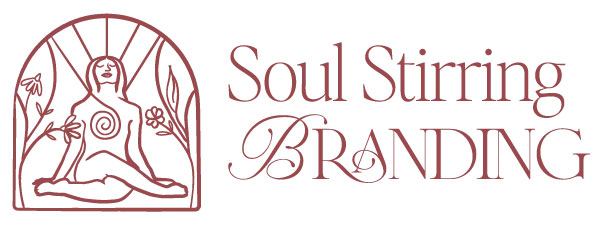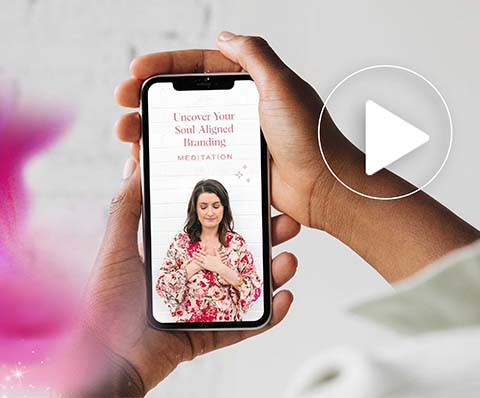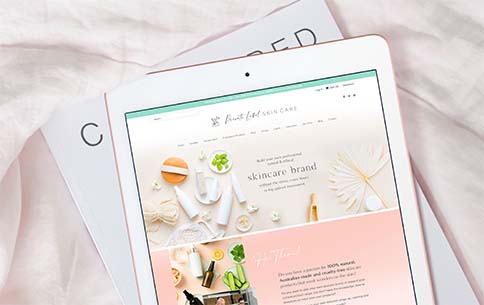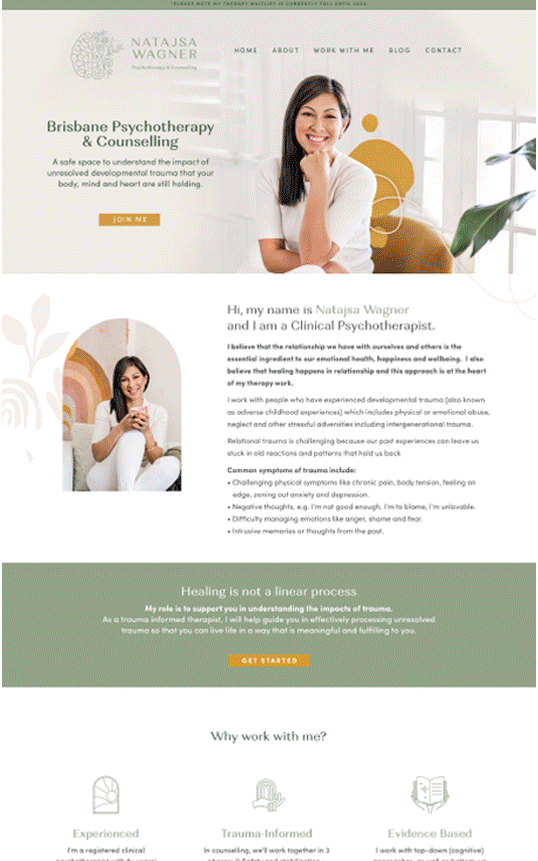Many of my clients are coaches or therapists, such as psychotherapists, counsellors, psychologists and life coaches.
As someone working in a helping, caring and transformational profession (and someone who has come across my website), you’re probably wanting your site to be a little different from others in your industry. Most therapy websites I have personally come across look outdated and masculine. Yet there are so many female therapists out there wanting to bring in a more modern, feminine, heartfelt vibe. So where do you even begin?
![]()
Balancing soul and science
In your copy, try to find a good balance between your soulful/connecting content and your proof of credibility and professionalism. When it comes to something as personal as speaking to a therapist, counsellor or coach, potential clients want to know they’ll feel comfortable sharing their biggest struggles with you and that they will feel a rapport and can relate to you. At the same time, many therapists and counsellors don’t want to appear to woo-woo or feel like they’re becoming too personal, so it’s all about striking a balance.
![]()
Examples of credible/professional content:
• the areas you work with/have a special interest in
• your qualifications
• information about your experience (years in industry, number of clients helped)
• evidence-based information/education
• features in press/awards received
• testimonials (if allowed in your industry, which is often not possible).
![]()
Examples of soulful/connecting content:
• your story/how you can empathise with the client
• heart-felt/lifestyle photography which gives people a sense of who you are
• copy which speaks directly to the reader and conveys their struggles and dreams
• sharing your values and why you’re passionate about the work you do
• videos or audios where people can hear your voice and connect with you
• A visual brand which gives people a sense of who you are and how you help.
![]()
Helping people understand what to expect
If someone is signing up to do therapy/counselling, it is usually quite intimidating. They’re not quite sure what to expect. The more you can paint the picture to help ease those nerves, the better. However, many people don’t like to write too much about what they do and how they work, as they feel individual sessions are so personalised to the clients’ needs. I completely get that, and how it can feel confusing how to explain what you do. But there is a way.
![]()
I would recommend you explain the general process in steps i.e.
• Before we start working together we’ll do X (discovery call, fill out questionnaire…)
• In our first session, here’s what to generally expect (usually first sessions tend to be about getting to know each other and finding out about the person’s history, so they may follow somewhat of a similar formula that you can talk about).
• In subsequent sessions, here is what to generally expect (you can talk about the recommended frequency of sessions, how each session builds on the next etc).
You could also do things like:
• A list of how you work and how you don’t work
• Some key parts of your approach that make it different from others
• Photos of your therapy space (if you do in-person sessions), hopefully, this gives people a sense of your vibe and if they would feel comfortable there.
• Try to be as helpful as possible with FAQs. If someone feels like their lingering question was not answered they will be less likely to make the first step to enquire.
Niche or create landing pages
I firmly believe in the value of picking a niche. Would you prefer to work with a therapist or counsellor who primarily works with the problem you’re facing and has an in-depth explanation of how they work with your problem and lots of blog posts and educational resources on the topic or someone who works with anxiety, depression, relationships, children, teens, anger management, grief, trauma and more? While most therapists seem to be generalists (especially if they have a team), picking one particular niche may be a great way to stand out.
Whether you choose to niche or not, I highly recommend creating landing pages for any of the key areas of therapy you work in, if you have more than one core focus. This is excellent for SEO and also helps the visitor feel like you will be able to help them with their specific area of struggle, even if you have not got one specific niche. It just takes longer to create your website if you don’t have a specific niche, as you’re having to create these landing pages for multiple areas, but it can certainly be done. For an example, I had a therapist client who created landing pages for all her key areas of focus (anxiety, depression, teens and trauma).
![]()
Give away something for free
An opt-in/lead magnet is a great way to offer something for free to demonstrate your knowledge and value, while at the same time building trust and getting people onto your email list so you can contact them with updates.
![]()
Possible freebie ideas
• An ebook with info or exercises
• A X number of days challenge, where info and exercises get drip-fed to them.
• A meditation audio
• A audio or video mini-course
![]()
Make booking with you easy
You don’t want to make people jump through hoops to book with you. This has to be super easy. It’s a great idea to have your booking link or phone number (however you want people to contact you/get started), in the header and the footer for easy access on every single page. Have lots of clear “Call to action” buttons on each page to provide a next step.
These are just some ideas on a very big topic! I hope it was helpful.
![]()
Examples of some of my Therapy & Counselling Clients websites for inspiration:
• Natajsa Wagner – Psychotherapist & Counsellor
• Sarah Tuckett – Somatic Psychotherapist & Counsellor • Wholistic Life Renewal – Life Coach
• Carissa Rodgers – Heart-centred Counsellor, Somatic Psychotherapist
• Reach Life – Mental Health & Counselling
• Kathy Milano – Psychologist, Soul Guide, Intuitive, and Artist
• Soulrise Psychotherapy – Psychotherapist










